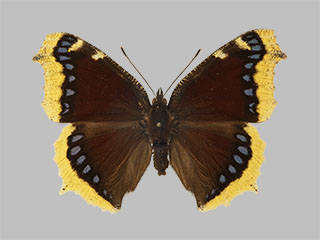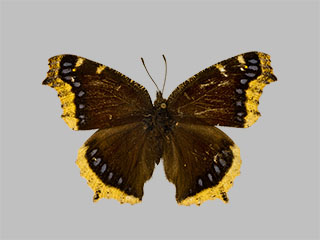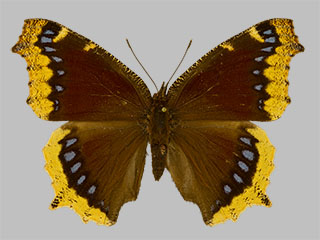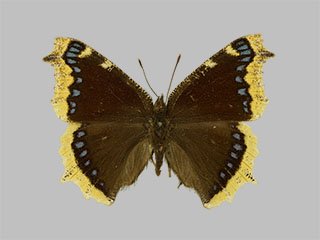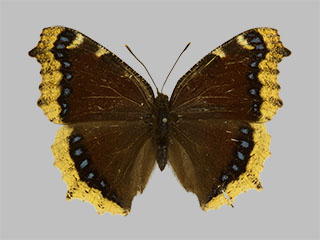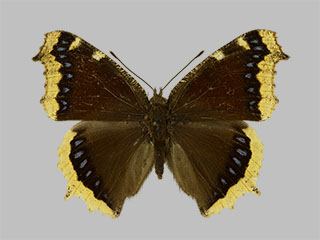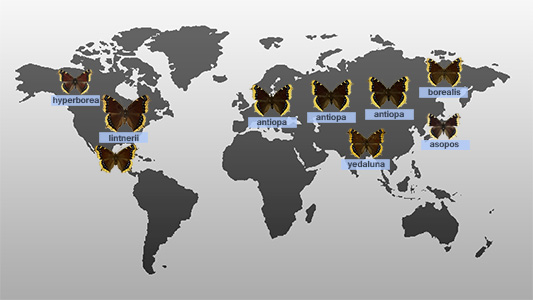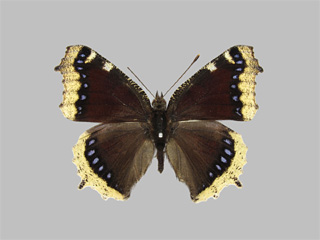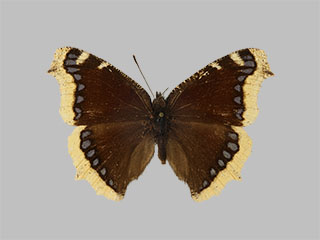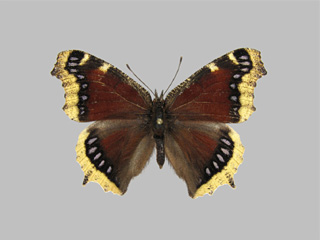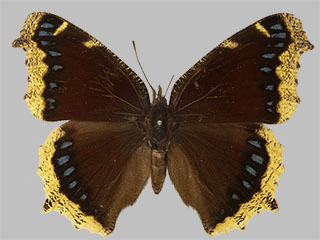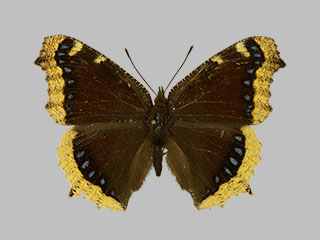|
|
|
|
|
|
|
Including the Swedish Nominiform or (new) nominotypic taxon: Taxon defined by the same name-bearing type as the higher-ranking taxon to which it itself belongs.Type Species  Camberwell BeautyNymphalis antiopa (Linnaeus, 1758)Mourning CloakNymphalis antiopa (Linnaeus, 1758) (see also Type specimen) described by Carl von Linné (1707-1778)Carl von Linné in 1758, the following subspecies and geographical races have been described:
Camberwell BeautyNymphalis antiopa (Linnaeus, 1758)Mourning CloakNymphalis antiopa (Linnaeus, 1758) (see also Type specimen) described by Carl von Linné (1707-1778)Carl von Linné in 1758, the following subspecies and geographical races have been described:
-
Nymphalis antiopa ssp. antiopaNymphalis antiopa ssp. antiopa (Linnaeus, 1758)Nymphalis antiopa ssp. antiopa Linnaeus, 1758
-
 Nymphalis antiopa ssp. asoposNymphalis antiopa ssp. asopos (Linnaeus, 1758)Nymphalis antiopa ssp. asopos Fruhstorfer, 1909
Nymphalis antiopa ssp. asoposNymphalis antiopa ssp. asopos (Linnaeus, 1758)Nymphalis antiopa ssp. asopos Fruhstorfer, 1909 -
 Nymphalis antiopa ssp. borealisNymphalis antiopa ssp. borealis (Linnaeus, 1758)Nymphalis antiopa ssp. borealis Wnukowsky, 1927
Nymphalis antiopa ssp. borealisNymphalis antiopa ssp. borealis (Linnaeus, 1758)Nymphalis antiopa ssp. borealis Wnukowsky, 1927 -
 Nymphalis antiopa ssp. hyperboreaNymphalis antiopa ssp. hyperborea (Linnaeus, 1758)Nymphalis antiopa ssp. hyperborea Seitz, 1914
Nymphalis antiopa ssp. hyperboreaNymphalis antiopa ssp. hyperborea (Linnaeus, 1758)Nymphalis antiopa ssp. hyperborea Seitz, 1914 -
 Nymphalis antiopa ssp. lintneriiNymphalis antiopa ssp. lintnerii (Linnaeus, 1758)Nymphalis antiopa ssp. lintnerii Fitch, 1856
Nymphalis antiopa ssp. lintneriiNymphalis antiopa ssp. lintnerii (Linnaeus, 1758)Nymphalis antiopa ssp. lintnerii Fitch, 1856 -
 Nymphalis antiopa ssp. yedalunaNymphalis antiopa ssp. yedaluna (Linnaeus, 1758)Nymphalis antiopa ssp. yedaluna Fruhstorfer, 1909
Nymphalis antiopa ssp. yedalunaNymphalis antiopa ssp. yedaluna (Linnaeus, 1758)Nymphalis antiopa ssp. yedaluna Fruhstorfer, 1909
Nymphalis antiopa ssp. antiopaNymphalis antiopa ssp. antiopa (Linnaeus, 1758)Nymphalis antiopa ssp. antiopa Linnaeus, 1758
This subspecies corresponds to the Nominiform or (new) nominotypic taxon: Taxon defined by the same name-bearing type as the higher-ranking taxon to which it itself belongs.Type Species from  Sweden
Sweden Sweden, which the Swede Carl von Linné (1707-1778)Carl von Linné (abbreviated L.) first described scientifically in 1758 von Linné, 1767 - Caroli a Linné, Systema Naturae, Tom. I. Pars II., Editio Duodecima Reformata. (see: Systematics).
Sweden, which the Swede Carl von Linné (1707-1778)Carl von Linné (abbreviated L.) first described scientifically in 1758 von Linné, 1767 - Caroli a Linné, Systema Naturae, Tom. I. Pars II., Editio Duodecima Reformata. (see: Systematics).
One example of the Nymphalis antiopa ssp. antiopaNymphalis antiopa ssp. antiopa (Linnaeus, 1758)Nymphalis antiopa ssp. antiopa:
 Camberwell BeautyNymphalis antiopa (Linnaeus, 1758)Mourning CloakCamberwell Beauty
Camberwell BeautyNymphalis antiopa (Linnaeus, 1758)Mourning CloakCamberwell Beauty
Nymphalis antiopa ssp. antiopa
[Breeding image; 67 mm; Male]
Egg 04/06/1941; hatched 13/06/1941; pupated 10/07/1941; hatched 28/07/1941
Collection: Museum Alexander Koenig, Bonn
Breeding:
Seddin, Brandenburg,  GermanySeddin, Brandenburg,
GermanySeddin, Brandenburg,  GermanyBrandenburg,
GermanyBrandenburg,  Germany
Germany Germany (28. July 1941)
Germany (28. July 1941)
For further specimens of the subspecies Nymphalis antiopa ssp. antiopaNymphalis antiopa ssp. antiopa (Linnaeus, 1758)Nymphalis antiopa ssp. antiopa see Photos of pinned Camberwell beauties (Nymphalis antiopa): Nymphalis antiopa ssp. antiopa.
On the naming of the subspecies Nymphalis antiopa ssp. antiopaNymphalis antiopa ssp. antiopa (Linnaeus, 1758)Nymphalis antiopa ssp. antiopa see Scientific Names.
 Nymphalis antiopa ssp. asoposNymphalis antiopa ssp. asopos (Linnaeus, 1758)Nymphalis antiopa ssp. asopos Fruhstorfer, 1909
Nymphalis antiopa ssp. asoposNymphalis antiopa ssp. asopos (Linnaeus, 1758)Nymphalis antiopa ssp. asopos Fruhstorfer, 1909
This subspecies occurs:
- in
 Japan
Japan Japan
Japan - on Sakhalin,
 RussiaSakhalin
RussiaSakhalin - on the Kuril Islands,
 RussiaKuril Islands (north or north-east of
RussiaKuril Islands (north or north-east of  Japan
Japan Japan)
Japan)
It was described in 1909 by German Insect scientistEntomologist Hans Fruhstorfer (1866-1922)Hans Fruhstorfer in Fruhstorfer, 1909 - Neue Vanessa- und Pyrameis-Rassen:
Vanessa (Euvanessa) antiopa asopos nov. subspec.
The blue submarginal margins of the upper side of the wings are longer and narrower, the yellow distal margin somewhat more dusted than in Europeans, which also applies to the white and somewhat narrower outer margin on the underside.
Patria: Japan.
 Nymphalis antiopa ssp. asoposNymphalis antiopa ssp. asopos (Linnaeus, 1758)Nymphalis antiopa ssp. asopos and for comparison the Nominiform or (new) nominotypic taxon: Taxon defined by the same name-bearing type as the higher-ranking taxon to which it itself belongs.Type Species Nymphalis antiopa ssp.Nymphalis antiopa ssp. (Linnaeus, 1758)Nymphalis antiopa ssp.:
Nymphalis antiopa ssp. asoposNymphalis antiopa ssp. asopos (Linnaeus, 1758)Nymphalis antiopa ssp. asopos and for comparison the Nominiform or (new) nominotypic taxon: Taxon defined by the same name-bearing type as the higher-ranking taxon to which it itself belongs.Type Species Nymphalis antiopa ssp.Nymphalis antiopa ssp. (Linnaeus, 1758)Nymphalis antiopa ssp.:
 Camberwell BeautyNymphalis antiopa (Linnaeus, 1758)Mourning CloakCamberwell Beauty
Camberwell BeautyNymphalis antiopa (Linnaeus, 1758)Mourning CloakCamberwell Beauty
Nymphalis antiopa ssp. asopos
[55 mm]
Collection: M. Yago
Catching:
Setana, Kariba (Mountain), Makomania (River), Hokkaidō,  JapanSetana, Kariba (Mountain), Makomania (River), Hokkaidō,
JapanSetana, Kariba (Mountain), Makomania (River), Hokkaidō,  JapanKariba (Mountain), Makomania (River), Hokkaidō,
JapanKariba (Mountain), Makomania (River), Hokkaidō,  Japan
Japan Japan (18. August 1990)
Japan (18. August 1990)
 Camberwell BeautyNymphalis antiopa (Linnaeus, 1758)Mourning CloakCamberwell Beauty
Camberwell BeautyNymphalis antiopa (Linnaeus, 1758)Mourning CloakCamberwell Beauty
Nymphalis antiopa ssp. antiopa
[Breeding image; 67 mm; Male]
Egg 04/06/1941; hatched 13/06/1941; pupated 10/07/1941; hatched 28/07/1941
Collection: Museum Alexander Koenig, Bonn
Breeding:
Seddin, Brandenburg,  GermanySeddin, Brandenburg,
GermanySeddin, Brandenburg,  GermanyBrandenburg,
GermanyBrandenburg,  Germany
Germany Germany (28. July 1941)
Germany (28. July 1941)
More specimens of the subspecies  Nymphalis antiopa ssp. asoposNymphalis antiopa ssp. asopos (Linnaeus, 1758)Nymphalis antiopa ssp. asopos see: Photos of pinned Camberwell beauties (Nymphalis antiopa): Nymphalis antiopa ssp. asopos
Nymphalis antiopa ssp. asoposNymphalis antiopa ssp. asopos (Linnaeus, 1758)Nymphalis antiopa ssp. asopos see: Photos of pinned Camberwell beauties (Nymphalis antiopa): Nymphalis antiopa ssp. asopos
On the naming of the subspecies  Nymphalis antiopa ssp. asoposNymphalis antiopa ssp. asopos (Linnaeus, 1758)Nymphalis antiopa ssp. asopos see Scientific Names.
Nymphalis antiopa ssp. asoposNymphalis antiopa ssp. asopos (Linnaeus, 1758)Nymphalis antiopa ssp. asopos see Scientific Names.
 Nymphalis antiopa ssp. borealisNymphalis antiopa ssp. borealis (Linnaeus, 1758)Nymphalis antiopa ssp. borealis Wnukowsky, 1927
Nymphalis antiopa ssp. borealisNymphalis antiopa ssp. borealis (Linnaeus, 1758)Nymphalis antiopa ssp. borealis Wnukowsky, 1927
This subspecies occurs:
It is smaller than the Nominiform or (new) nominotypic taxon: Taxon defined by the same name-bearing type as the higher-ranking taxon to which it itself belongs.Type Species Nymphalis antiopa ssp. antiopaNymphalis antiopa ssp. antiopa (Linnaeus, 1758)Nymphalis antiopa ssp. antiopa.
Woldemar WnukowskyWoldemar Wnukowsky describes the subspecies in Wnukowsky, 1927 - Neue Lepidopterenformen aus Nordost-Sibirien und dem Mongolischen Altai.:
Vanessa (Euvanessa) antiopa L. borealis subsp. nov.
Diagnosis: antiopa typ. similis, sed leviter minor (53-55 mm).
Patria: Siberia septentrionalis-orientalis (Jakutsk).
Typi in coli. Musei Zoolog. Universitatis Tomskensis (ad urbem Jakutsk, G. Antonovitsh leg.).
This north-east Siberian race differs from the typical representatives by its somewhat smaller size (53-55 mm). Described from specimens from the city of Yakutsk (G. Antonovich leg.). Types are in the collection of the Zoological Museum of Tomsk State University.
 Nymphalis antiopa ssp. borealisNymphalis antiopa ssp. borealis (Linnaeus, 1758)Nymphalis antiopa ssp. borealis and for comparison the Nominiform or (new) nominotypic taxon: Taxon defined by the same name-bearing type as the higher-ranking taxon to which it itself belongs.Type Species Nymphalis antiopa ssp.Nymphalis antiopa ssp. (Linnaeus, 1758)Nymphalis antiopa ssp.:
Nymphalis antiopa ssp. borealisNymphalis antiopa ssp. borealis (Linnaeus, 1758)Nymphalis antiopa ssp. borealis and for comparison the Nominiform or (new) nominotypic taxon: Taxon defined by the same name-bearing type as the higher-ranking taxon to which it itself belongs.Type Species Nymphalis antiopa ssp.Nymphalis antiopa ssp. (Linnaeus, 1758)Nymphalis antiopa ssp.:
 Camberwell BeautyNymphalis antiopa (Linnaeus, 1758)Mourning CloakCamberwell Beauty
Camberwell BeautyNymphalis antiopa (Linnaeus, 1758)Mourning CloakCamberwell Beauty
Nymphalis antiopa ssp. borealis
[60 mm]
Collection: Museum Alexander Koenig, Bonn
Catching:
Tschita, Daurien (Transbaikal),  RussiaTschita, Daurien (Transbaikal),
RussiaTschita, Daurien (Transbaikal),  RussiaDaurien (Transbaikal),
RussiaDaurien (Transbaikal),  Russia
Russia Russia (May 1920)
Russia (May 1920)
 Camberwell BeautyNymphalis antiopa (Linnaeus, 1758)Mourning CloakCamberwell Beauty
Camberwell BeautyNymphalis antiopa (Linnaeus, 1758)Mourning CloakCamberwell Beauty
Nymphalis antiopa ssp. antiopa
[Breeding image; 67 mm; Male]
Egg 04/06/1941; hatched 13/06/1941; pupated 10/07/1941; hatched 28/07/1941
Collection: Museum Alexander Koenig, Bonn
Breeding:
Seddin, Brandenburg,  GermanySeddin, Brandenburg,
GermanySeddin, Brandenburg,  GermanyBrandenburg,
GermanyBrandenburg,  Germany
Germany Germany (28. July 1941)
Germany (28. July 1941)
More specimens of the subspecies  Nymphalis antiopa ssp. borealisNymphalis antiopa ssp. borealis (Linnaeus, 1758)Nymphalis antiopa ssp. borealis see: Photos of pinned Camberwell beauties (Nymphalis antiopa): Nymphalis antiopa ssp. borealis
Nymphalis antiopa ssp. borealisNymphalis antiopa ssp. borealis (Linnaeus, 1758)Nymphalis antiopa ssp. borealis see: Photos of pinned Camberwell beauties (Nymphalis antiopa): Nymphalis antiopa ssp. borealis
On the naming of the subspecies  Nymphalis antiopa ssp. borealisNymphalis antiopa ssp. borealis (Linnaeus, 1758)Nymphalis antiopa ssp. borealis see Scientific Names.
Nymphalis antiopa ssp. borealisNymphalis antiopa ssp. borealis (Linnaeus, 1758)Nymphalis antiopa ssp. borealis see Scientific Names.
 Nymphalis antiopa ssp. hyperboreaNymphalis antiopa ssp. hyperborea (Linnaeus, 1758)Nymphalis antiopa ssp. hyperborea Seitz, 1914
Nymphalis antiopa ssp. hyperboreaNymphalis antiopa ssp. hyperborea (Linnaeus, 1758)Nymphalis antiopa ssp. hyperborea Seitz, 1914
This subspecies occurs:
- in North America
It differs from the Nominiform or (new) nominotypic taxon: Taxon defined by the same name-bearing type as the higher-ranking taxon to which it itself belongs.Type Species Nymphalis antiopa ssp. antiopaNymphalis antiopa ssp. antiopa (Linnaeus, 1758)Nymphalis antiopa ssp. antiopa due to a smaller size, darker borders and larger spots Scott, 1986 - The Butterflies of North America - A Natural History and Field Guide.
Adalbert Seitz (1860-1938)Adalbert Seitz describes the subspecies in Seitz, 1924 - The Macrolepidoptera of the World: A systematic description of the hitherto known Macrolepidoptera:
...north, in Alaska. From there a specimen lies before me with very bright red-brown upper surface, white (not worn) margin slightly tinged with violet and on the under surface a light band across the middle of both wings; I figure it under the name hyperborea. rea form. nov. (93 f ).
 Nymphalis antiopa ssp. hyperboreaNymphalis antiopa ssp. hyperborea (Linnaeus, 1758)Nymphalis antiopa ssp. hyperborea and for comparison the Nominiform or (new) nominotypic taxon: Taxon defined by the same name-bearing type as the higher-ranking taxon to which it itself belongs.Type Species Nymphalis antiopa ssp.Nymphalis antiopa ssp. (Linnaeus, 1758)Nymphalis antiopa ssp.:
Nymphalis antiopa ssp. hyperboreaNymphalis antiopa ssp. hyperborea (Linnaeus, 1758)Nymphalis antiopa ssp. hyperborea and for comparison the Nominiform or (new) nominotypic taxon: Taxon defined by the same name-bearing type as the higher-ranking taxon to which it itself belongs.Type Species Nymphalis antiopa ssp.Nymphalis antiopa ssp. (Linnaeus, 1758)Nymphalis antiopa ssp.:
 Camberwell BeautyNymphalis antiopa (Linnaeus, 1758)Mourning CloakCamberwell Beauty
Camberwell BeautyNymphalis antiopa (Linnaeus, 1758)Mourning CloakCamberwell Beauty
Nymphalis antiopa ssp. hyperborea
[57 mm]
Catching:
Norbert KondlaNorbert Kondla leg.; Delta Junction, Alaska,  United StatesDelta Junction, Alaska,
United StatesDelta Junction, Alaska,  United StatesAlaska,
United StatesAlaska,  United States
United States United States (19. August 2005)
United States (19. August 2005)
 Camberwell BeautyNymphalis antiopa (Linnaeus, 1758)Mourning CloakCamberwell Beauty
Camberwell BeautyNymphalis antiopa (Linnaeus, 1758)Mourning CloakCamberwell Beauty
Nymphalis antiopa ssp. antiopa
[Breeding image; 67 mm; Male]
Egg 04/06/1941; hatched 13/06/1941; pupated 10/07/1941; hatched 28/07/1941
Collection: Museum Alexander Koenig, Bonn
Breeding:
Seddin, Brandenburg,  GermanySeddin, Brandenburg,
GermanySeddin, Brandenburg,  GermanyBrandenburg,
GermanyBrandenburg,  Germany
Germany Germany (28. July 1941)
Germany (28. July 1941)
Joseph BelicekJoseph Belicek analysed and described the subspecies  Nymphalis antiopa ssp. hyperboreaNymphalis antiopa ssp. hyperborea (Linnaeus, 1758)Nymphalis antiopa ssp. hyperborea in more detail in 2013 Belicek, 2013 - Notes on the Holotype of Nymphalis antiopa hyperborea (Seitz, 1914). As a result, he significantly expanded the area of distribution usually cited until then (originally AlaskaAlaska Seitz, 1924 - The Macrolepidoptera of the World: A systematic description of the hitherto known Macrolepidoptera and northern
Nymphalis antiopa ssp. hyperboreaNymphalis antiopa ssp. hyperborea (Linnaeus, 1758)Nymphalis antiopa ssp. hyperborea in more detail in 2013 Belicek, 2013 - Notes on the Holotype of Nymphalis antiopa hyperborea (Seitz, 1914). As a result, he significantly expanded the area of distribution usually cited until then (originally AlaskaAlaska Seitz, 1924 - The Macrolepidoptera of the World: A systematic description of the hitherto known Macrolepidoptera and northern  Canada
Canada Canada):
Canada):
...presently known from a large area on the North American continent. Ranging from Alaska, across Canada and the northern tier of states in the United States. Southward, specimens are known from North Carolina.
For more specimens of the subspecies  Nymphalis antiopa ssp. hyperboreaNymphalis antiopa ssp. hyperborea (Linnaeus, 1758)Nymphalis antiopa ssp. hyperborea see Photos of pinned Camberwell beauties (Nymphalis antiopa): Nymphalis antiopa ssp. hyperborea.
Nymphalis antiopa ssp. hyperboreaNymphalis antiopa ssp. hyperborea (Linnaeus, 1758)Nymphalis antiopa ssp. hyperborea see Photos of pinned Camberwell beauties (Nymphalis antiopa): Nymphalis antiopa ssp. hyperborea.
On the naming of the subspecies  Nymphalis antiopa ssp. hyperboreaNymphalis antiopa ssp. hyperborea (Linnaeus, 1758)Nymphalis antiopa ssp. hyperborea see Scientific Names.
Nymphalis antiopa ssp. hyperboreaNymphalis antiopa ssp. hyperborea (Linnaeus, 1758)Nymphalis antiopa ssp. hyperborea see Scientific Names.
 Nymphalis antiopa ssp. lintneriiNymphalis antiopa ssp. lintnerii (Linnaeus, 1758)Nymphalis antiopa ssp. lintnerii Fitch, 1856
Nymphalis antiopa ssp. lintneriiNymphalis antiopa ssp. lintnerii (Linnaeus, 1758)Nymphalis antiopa ssp. lintnerii Fitch, 1856
This subspecies occurs:
- in North America
It was identified by I. A. LintnerI. A. Lintner in the US state of New York,  United StatesNew York Fitch, 1856 - Third Report on the Noxious, Beneficial and Other Insects of the State of New York. The wings are darker with a wider yellow border and smaller blue spots Rebel, 1910 - Fr. Berge's Schmetterlingsbuch nach dem gegenwärtigen Stande der Lepidopterologie. The subspecies was previously also partially categorised as A genetic or environmentally produced variation on the usual form of the speciesaberration (ab. lintnéri Fitch) Rebel, 1910 - Fr. Berge's Schmetterlingsbuch nach dem gegenwärtigen Stande der Lepidopterologie.
United StatesNew York Fitch, 1856 - Third Report on the Noxious, Beneficial and Other Insects of the State of New York. The wings are darker with a wider yellow border and smaller blue spots Rebel, 1910 - Fr. Berge's Schmetterlingsbuch nach dem gegenwärtigen Stande der Lepidopterologie. The subspecies was previously also partially categorised as A genetic or environmentally produced variation on the usual form of the speciesaberration (ab. lintnéri Fitch) Rebel, 1910 - Fr. Berge's Schmetterlingsbuch nach dem gegenwärtigen Stande der Lepidopterologie.
Asa Fitch (1809-1879)Asa Fitch writes in Fitch, 1856 - Third Report on the Noxious, Beneficial and Other Insects of the State of New York:
... This butterfly is closely related to tha Antiopa or White-bordered butterfly, a species which is common upon both sides of the Atlantic. Its wings have perfectly the same form and are similarly colored to those of the Antiopa, but their pale border is twice as broad as in that species, occupying a third of the length of the wings, and it is wholly destitute of the row of blue spots which occur in Antiopa forward of the border. Its ground color is deep rusty brown, much more tinged with liver-reddish than in Antiopa. ...
 Nymphalis antiopa ssp. lintneriiNymphalis antiopa ssp. lintnerii (Linnaeus, 1758)Nymphalis antiopa ssp. lintnerii and for comparison the Nominiform or (new) nominotypic taxon: Taxon defined by the same name-bearing type as the higher-ranking taxon to which it itself belongs.Type Species Nymphalis antiopa ssp.Nymphalis antiopa ssp. (Linnaeus, 1758)Nymphalis antiopa ssp.:
Nymphalis antiopa ssp. lintneriiNymphalis antiopa ssp. lintnerii (Linnaeus, 1758)Nymphalis antiopa ssp. lintnerii and for comparison the Nominiform or (new) nominotypic taxon: Taxon defined by the same name-bearing type as the higher-ranking taxon to which it itself belongs.Type Species Nymphalis antiopa ssp.Nymphalis antiopa ssp. (Linnaeus, 1758)Nymphalis antiopa ssp.:
 Camberwell BeautyNymphalis antiopa (Linnaeus, 1758)Mourning CloakCamberwell Beauty
Camberwell BeautyNymphalis antiopa (Linnaeus, 1758)Mourning CloakCamberwell Beauty
Nymphalis antiopa ssp. lintnerii
[79,5 mm; Female]
Collection: Museum Alexander Koenig, Bonn
Catching:
Texas,  United StatesTexas,
United StatesTexas,  United States
United States United States (1897)
United States (1897)
 Camberwell BeautyNymphalis antiopa (Linnaeus, 1758)Mourning CloakCamberwell Beauty
Camberwell BeautyNymphalis antiopa (Linnaeus, 1758)Mourning CloakCamberwell Beauty
Nymphalis antiopa ssp. antiopa
[Breeding image; 67 mm; Male]
Egg 04/06/1941; hatched 13/06/1941; pupated 10/07/1941; hatched 28/07/1941
Collection: Museum Alexander Koenig, Bonn
Breeding:
Seddin, Brandenburg,  GermanySeddin, Brandenburg,
GermanySeddin, Brandenburg,  GermanyBrandenburg,
GermanyBrandenburg,  Germany
Germany Germany (28. July 1941)
Germany (28. July 1941)
1887 Arthur Gardiner Butler (1844-1924)Arthur Gardiner Butler assigned  Nymphalis antiopa ssp. lintneriiNymphalis antiopa ssp. lintnerii (Linnaeus, 1758)Nymphalis antiopa ssp. lintnerii as A genetic or environmentally produced variation on the usual form of the speciesaberration, which he also found to be very similar to the A genetic or environmentally produced variation on the usual form of the speciesaberration
Nymphalis antiopa ssp. lintneriiNymphalis antiopa ssp. lintnerii (Linnaeus, 1758)Nymphalis antiopa ssp. lintnerii as A genetic or environmentally produced variation on the usual form of the speciesaberration, which he also found to be very similar to the A genetic or environmentally produced variation on the usual form of the speciesaberration  Nymphalis antiopa f. hygiaeaNymphalis antiopa f. hygiaea (Linnaeus, 1758)Nymphalis antiopa f. hygiaea Butler, 1887 - Description of a new Butterfly allied to Vanessa antiopa:
Nymphalis antiopa f. hygiaeaNymphalis antiopa f. hygiaea (Linnaeus, 1758)Nymphalis antiopa f. hygiaea Butler, 1887 - Description of a new Butterfly allied to Vanessa antiopa:
The forms differing from type of V. antiopa - V. hygiaea, from Europe, and V.Lintneri, from the United States - are regarded, with every likelihood of being right, as aberrations of the species; judging from Hübner's figure (lettered "antiopa") and Fitch's description, thees aberrations appear to be very similar, differing chiefly from the normal for in the absence of many of th blue spots and the slightly wider yellow border of all the wings.
For more specimens of the subspecies  Nymphalis antiopa ssp. lintneriiNymphalis antiopa ssp. lintnerii (Linnaeus, 1758)Nymphalis antiopa ssp. lintnerii see Photos of pinned Camberwell beauties (Nymphalis antiopa): Nymphalis antiopa ssp. lintnerii.
Nymphalis antiopa ssp. lintneriiNymphalis antiopa ssp. lintnerii (Linnaeus, 1758)Nymphalis antiopa ssp. lintnerii see Photos of pinned Camberwell beauties (Nymphalis antiopa): Nymphalis antiopa ssp. lintnerii.
On the naming of the subspecies  Nymphalis antiopa ssp. lintneriiNymphalis antiopa ssp. lintnerii (Linnaeus, 1758)Nymphalis antiopa ssp. lintnerii see Scientific Names.
Nymphalis antiopa ssp. lintneriiNymphalis antiopa ssp. lintnerii (Linnaeus, 1758)Nymphalis antiopa ssp. lintnerii see Scientific Names.
 Nymphalis antiopa ssp. yedalunaNymphalis antiopa ssp. yedaluna (Linnaeus, 1758)Nymphalis antiopa ssp. yedaluna Fruhstorfer, 1909
Nymphalis antiopa ssp. yedalunaNymphalis antiopa ssp. yedaluna (Linnaeus, 1758)Nymphalis antiopa ssp. yedaluna Fruhstorfer, 1909
This subspecies occurs (Quelle: ENVIS (Environmental Information System) on Faunal Diversity (2011)):
- in Chumbi-Valley, Tibet,
 ChinaChumbi-Valley
ChinaChumbi-Valley - in Triangle
 India
India India/Tibet,
India/Tibet,  ChinaTibet/
ChinaTibet/ Bhutan
Bhutan Bhutan
Bhutan - in Manipur,
 IndiaManipur
IndiaManipur
It was described in 1909 by the German entomologist Hans Fruhstorfer (1866-1922)Hans Fruhstorfer and caught by him at the Chumbi Pass in July/August 1912. It is a subspecies with only slight variation, the occurrence of which has declined significantly.
Hans Fruhstorfer (1866-1922)Hans Fruhstorfer describes the subspecies in Fruhstorfer, 1909 - Neue Vanessa- und Pyrameis-Rassen:
Vanessa antiopa yedanula nov. subspec.
(Yedanula Name of the deceased Empress of China.)
Smaller than the previous one  Nymphalis antiopa ssp. asoposNymphalis antiopa ssp. asopos (Linnaeus, 1758)Nymphalis antiopa ssp. asopos; the white outer border on the underside is narrower, even more densely dotted in black; Distal margin of the upper side darker yellow than in Europeans; the subapical spots are narrower, more reminiscent of the American form.
Nymphalis antiopa ssp. asoposNymphalis antiopa ssp. asopos (Linnaeus, 1758)Nymphalis antiopa ssp. asopos; the white outer border on the underside is narrower, even more densely dotted in black; Distal margin of the upper side darker yellow than in Europeans; the subapical spots are narrower, more reminiscent of the American form.
Patria: China, Szetchuan, Type of Siao-Lou. Of Europeans, South Tyroleans ♂ ♂ are the largest, those from Finland and the Urals the smallest.
 Nymphalis antiopa ssp. yedalunaNymphalis antiopa ssp. yedaluna (Linnaeus, 1758)Nymphalis antiopa ssp. yedaluna and for comparison the Nominiform or (new) nominotypic taxon: Taxon defined by the same name-bearing type as the higher-ranking taxon to which it itself belongs.Type Species Nymphalis antiopa ssp.Nymphalis antiopa ssp. (Linnaeus, 1758)Nymphalis antiopa ssp.:
Nymphalis antiopa ssp. yedalunaNymphalis antiopa ssp. yedaluna (Linnaeus, 1758)Nymphalis antiopa ssp. yedaluna and for comparison the Nominiform or (new) nominotypic taxon: Taxon defined by the same name-bearing type as the higher-ranking taxon to which it itself belongs.Type Species Nymphalis antiopa ssp.Nymphalis antiopa ssp. (Linnaeus, 1758)Nymphalis antiopa ssp.:
 Camberwell BeautyNymphalis antiopa (Linnaeus, 1758)Mourning CloakCamberwell Beauty
Camberwell BeautyNymphalis antiopa (Linnaeus, 1758)Mourning CloakCamberwell Beauty
Nymphalis antiopa ssp. yedaluna
[66 mm]
Collection: Museum Alexander Koenig, Bonn
Subcollection: Hermann Höne (1883-1963)Hermann Höne
Catching:
Lijiang, Yúnnán,  ChinaLijiang, Yúnnán,
ChinaLijiang, Yúnnán,  ChinaYúnnán,
ChinaYúnnán,  China
China China (29. August 1935)
China (29. August 1935)
 Camberwell BeautyNymphalis antiopa (Linnaeus, 1758)Mourning CloakCamberwell Beauty
Camberwell BeautyNymphalis antiopa (Linnaeus, 1758)Mourning CloakCamberwell Beauty
Nymphalis antiopa ssp. antiopa
[Breeding image; 67 mm; Male]
Egg 04/06/1941; hatched 13/06/1941; pupated 10/07/1941; hatched 28/07/1941
Collection: Museum Alexander Koenig, Bonn
Breeding:
Seddin, Brandenburg,  GermanySeddin, Brandenburg,
GermanySeddin, Brandenburg,  GermanyBrandenburg,
GermanyBrandenburg,  Germany
Germany Germany (28. July 1941)
Germany (28. July 1941)
For more specimens of the subspecies  Nymphalis antiopa ssp. yedalunaNymphalis antiopa ssp. yedaluna (Linnaeus, 1758)Nymphalis antiopa ssp. yedaluna see Photos of pinned Camberwell beauties (Nymphalis antiopa): Nymphalis antiopa ssp. yedaluna.
Nymphalis antiopa ssp. yedalunaNymphalis antiopa ssp. yedaluna (Linnaeus, 1758)Nymphalis antiopa ssp. yedaluna see Photos of pinned Camberwell beauties (Nymphalis antiopa): Nymphalis antiopa ssp. yedaluna.
On the naming of the subspecies  Nymphalis antiopa ssp. yedalunaNymphalis antiopa ssp. yedaluna (Linnaeus, 1758)Nymphalis antiopa ssp. yedaluna see Scientific Names.
Nymphalis antiopa ssp. yedalunaNymphalis antiopa ssp. yedaluna (Linnaeus, 1758)Nymphalis antiopa ssp. yedaluna see Scientific Names.




